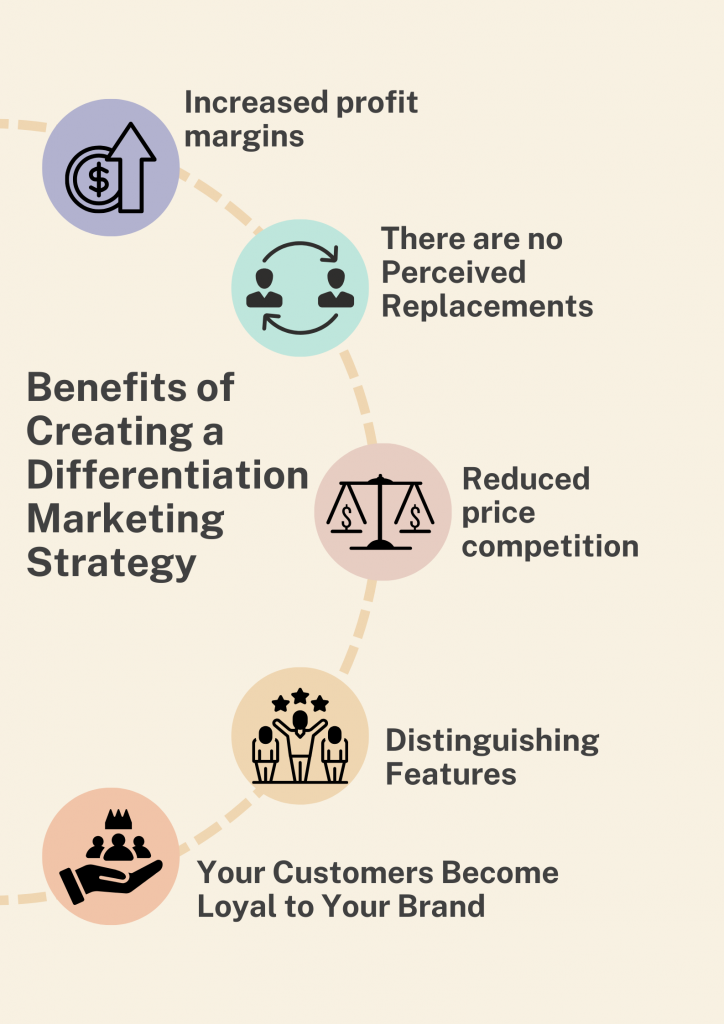In today’s crowded business world, making your brand stand out is tough. My writing experience has allowed me to work with many companies across different industries, all struggling with the same challenge: how to differentiate themselves from competitors (differentiated marketing).
I remember one project with a startup making consumer electronics products. Despite having great, innovative products, they were getting lost in the shuffle. Customers couldn’t see what made them unique and special compared to other brands.
We realized they needed a differentiated marketing strategy to highlight what made their brand different and better. We got to work crafting a plan to emphasize their one-of-a-kind brand story and selling points that truly set them apart.
The results were amazing. This once-overlooked startup suddenly started capturing attention and interest. Customers recognized what made them stand out as the unique option in a sea of sameness.
This experience showed me just how powerful differentiation can be for any business trying to succeed in an overcrowded market. You can’t just blend in – you have to make your brand stand out as the preferable choice intentionally.
That’s exactly what this guide will help you do. We’ll explore different techniques for implementing a differentiated marketing approach to make your brand unique, memorable, and the obvious choice for your target customers. From highlighting your special selling points to telling a compelling brand story, you’ll learn how to cement your one-of-a-kind identity.
Key Points
- Establishing distinct and appealing character features provides constant emotional engagement across digital platforms, print materials, and physical venues.
- Category development aims to position oneself as an industry leader rather than a distant second in your primary market.
- Effective storytelling engages with people, resonates with them, and ultimately helps you sell more.
What is Differentiated Marketing?
Differentiated marketing is a method for brands to reach different target audience segments. Like any instrument, it has benefits and drawbacks. Differentiated marketing, also known as segmented marketing, is a marketing strategy that targets a specific market or consumer sector. It involves developing distinct marketing efforts to maximize brand awareness among your target audience’s varied consumer bases.
What is the Differentiated Strategy?
A differentiation strategy is a business strategy that separates a product to set it apart from competitors and more effectively engage a target audience. You can differentiate your product by emphasizing reduced prices, specialized features, and superior quality to build brand awareness and market share. If you target a certain market, you have a focused differentiation strategy. If your target market is diverse, you have a broad differentiation strategy.
Why Brand-Differentiated Marketing Matters
In today’s congested environment, you, as a large or small business enterprise, must differentiate yourself to attract clients. This is where a great brand can make a significant difference. You can separate yourself from competitors by developing a compelling brand with distinctive features, higher-quality products or services, and exceptional customer service.
Investment in brand development is crucial for any firm, whether existing or new and can have serious results on success. As competition grows, it will become increasingly difficult to distinguish yourself in today’s digital market.
Types of Brand Differentiation Marketing
Brand distinction can take various forms. I’ll discuss the types of brand differentiation: product, service, and channel.
Now, let’s go over them in detail…
#1. Product Differentiation
Product differentiation is an effective business approach. It gives businesses a competitive advantage and enables them to stand out in the marketplace. For instance, customers looking for something unique or more advanced, like the example I gave in the introduction, are frequently drawn to distinguishing features and items that provide better value than competitors.
Product differentiation has recently become critical for surviving and retaining market leadership. In this ever-changing commercial world, having distinctive offers and staying current on current trends will help any organization get on track.
#2. Service Differentiation
One strategy for firms to thrive is to emphasize a positive customer experience, such as offering excellent service, reducing shipping times, or establishing personalized customer visits.
A firm whose commitment to exceeding expectations with its customer experience by providing free carriers and returns, a flexible return expiration date and always-available customer service capabilities has earned the trust of typically unbeatable buyers who value the company’s investment in exceptional care.
#3. Channel Differentiation
I constantly encourage firms to make an effort towards channel differentiation. It’s essential for distinguishing oneself from competitors. This entails developing shops or platforms unique to your business and offering something customers cannot get from any other provider. I know of a small company that is into plastic production and has become a giant in the industry using this strategy while selling its plastics in local storefronts and online.
This direct-to-consumer model gives this plastic company an advantage over competitors. It allows it to offer reasonable rates while also providing a wonderful customer experience that keeps customers happy. Do you want to remain competitive and attract new customers? Take inspiration from this plastic company’s success and focus on developing a one-of-a-kind distribution plan that will set your business apart!
Differentiated Marketing Checklist.pdf
Strategies for Differentiation Marketing
Some prominent tactics include developing a unique selling proposition, building emotional branding, personalizing encounters, and forming co-branding strategic collaborations.
Here are some steps I have outlined to help firms stand out in a crowded landscape while fostering emotional connections with their customers. This also leads to improved consumer loyalty, which finally translates into profitability for the business.
#1. Emotional Branding
This is my number one strategy for any successful business plan. Emotional branding is an efficient method for creating a unique connection between customers and a firm. Engaging with audiences is required to cultivate loyal patronage and long-term connections. Organizations should prioritize storytelling, developing an appropriate brand identity, and incorporating visually appealing and emotive language into marketing materials to establish an emotional relationship.
So many companies can effectively use emotion to explain product qualities, offer meaning to their consumers’ purchasing decisions, and match customers with brand values. Establishing distinct and appealing character features provides constant emotional engagement across digital platforms, print materials, and physical venues. Ideally, this will go beyond corporate promotional strategies and elicit genuine emotion from people.
#2. Unique Selling Proposition
A unique selling proposition (USP) is an effective strategy for attracting customers to your product or service. It can help you differentiate yourself from the competition and attract potential buyers’ attention with unique features or benefits that symbolize your product’s value.
When used effectively in marketing and advertising, a unique selling proposition can persuade clients to choose you above alternative options. Targeted messaging and the right communication channels can increase its impact, making your company recognizable to clients and stand out from their other possibilities. Businesses that emphasize the good aspects of their offer have a better chance of becoming memorable in their market.
#3. Personalization
Personalization is the point at which you own the business. It is an effective tool for creating a unique consumer experience. Companies can use personalization to tailor product suggestions and marketing to individual customers, boosting customer loyalty and lifetime value. However, such techniques are fraught with complications. Companies must acquire and analyze client data optimally and invest in supporting technologies for personalization.
It is essential to recognize that personalization must be balanced against other potential sources of brand differentiation, such as product or service quality or competitive pricing methods. Finally, it is critical to recognize that only some products or services allow such targeted techniques; organizations must carefully analyze relative risk in these circumstances.
How to Implement Brand Differentiation Strategies
Here are five differentiation strategies that might help your brand stand out.
#1. Prioritize Openness and Ethics
Most brands focus heavily on ethics and transparency while promoting their products and services. The desire for openness, particularly in the case of influencer marketing, is gradually rising dramatically. Brands are distinguishing themselves by being radically upfront about their offerings. This demonstrates to clients how strongly the brands believe in their offerings.
Have you heard of the popular “LUSH” company? LUSH cosmetics is a prime illustration of this. LUSH debuted late in an already saturated market: the beauty business. Regardless, the brand has expanded to operate in more than 40 countries and is progressing in a competitive market.
Lush’s initial point of differentiation is transparency, not only in terms of ingredients but also in the manufacturing process. I can testify to their unique product. I used their relaxer once, and I felt the texture of my hair. The level of moisturizing was top-notch. Most Lush products contain fruits and vegetables. Furthermore, they use handmade products, which their clients like.
In my research, I discovered that before the company started making its products available to the public, the corporation tested them on human volunteers rather than their analysis. It also participates in donations and philanthropic campaigns, such as the Charity Pot campaign.
#2. Reposition Your Brand
Creating a new product category allows you to stand out much more readily. A company CEO once told me that category design helps your company stand out by separating it from a congested market and entering a niche. Category development aims to position oneself as an industry leader rather than a distant second in your primary market.
This is a time-consuming process that is similar to building your brand. Often, it entails completely rejecting your current business strategy and constructing a new one. Because there are faster and simpler solutions for brand differentiation, there may be better choices for some organizations trying to differentiate their brand. Category creation, like brand building, requires attention, involvement, and consistency from your whole business since it
#3. Establish exclusivity
Many companies and brands use exclusivity. You can make your brand more appealing by stating it is not for them. Exclusivity is a generic term, and various brands use it to differentiate themselves. These brands ensure that their products are not only difficult to obtain but also incredibly valuable and premium, such as Apple. This characteristic of the products frequently piques the curiosity of buyers who need help affording them.
#4. Develop a Distinct Visual Identity
Your products, marketing, commercials, and other material can stand out in a crowded market by using your brand’s voice and visual identity. A distinct visual identity is one approach to distinguishing your products from those of competitors and enhancing brand awareness.
Physical products require a strong visual identity to stand out on retail store shelves, which will be displayed alongside other products. Bold colours or a striking illustration might also assist. Customers will more likely recognize your commercials, emails, and social media postings if you have a distinct online brand identity, even if they do not explicitly mention your items.
#5. Create a Narrative
People relate to stories more than numbers and facts, so developing a unique, real, and memorable brand story will help customers remember your company and form a stronger emotional bond with it. Effective storytelling engages with people, resonates with them, and ultimately helps you sell more.
#6. Provide High-Quality Products
Your products act as a physical reflection of your brand for your customers. Thus, highlighting the quality of your items will help you distinguish yourself from the competitors. For non-physical objects like software, this encompasses the user experience and interface, design language, software ecosystem, etc.
#7. Customer Service Should Take Precedence
When consumers enjoy exceptional customer service, their contact with the business improves, and they are more likely to recommend it to their friends and family. Outstanding customer service allows you to retain more clients while distinguishing yourself from competitors.
Benefits of Developing a Differentiation Marketing Strategy
Differentiation tactics have various advantages that help you carve out a unique niche in your business. Here are the potential advantages of developing a differentiation strategy:

#1. Increased profit margins
Have you noticed that when products are differentiated and transformed into higher-quality products, there is a greater chance of higher profit margins? Well, I have, and if you pay close attention, you will too. For example, if your target market is ready to pay a premium for superior quality or value, you may make more income with fewer sales.
#2. There are no Perceived Replacements
An effective differentiation strategy promotes the concept that no other product on the market can be substituted for it. Even when equivalent products are available, a company will establish a competitive edge because customers are unwilling to replace one with another. Companies attempt to differentiate themselves by offering consumers unique, frequently revolutionised products.
#3. Reduced price competition
A differentiation strategy enables a corporation to compete in the market on terms other than reduced prices. For example, a candy manufacturer can distinguish itself by increasing the taste or employing healthier ingredients. Although its competitors sell cheaper candy, they cannot match the taste consumers may expect from that particular candy firm.
#4. Distinguishing Features
A differentiation approach has the advantage of focusing on a product’s distinguishing features. Your company may compile a list of product features your competitors do not have. These features will set your product apart, and you can communicate this through good marketing and promotion.
#5. Your Customers Become Loyal to Your Brand
If a company maintains the perceived quality of its products, effective differentiation can lead to brand loyalty among customers. For example, if a sports star markets your brand, it is likely to increase brand loyalty because it adds value to your brand.
What is an example of differentiation in marketing?
Product differentiation occurs when a corporation stresses a feature of a new product that distinguishes it from others on the market. Tesla, for example, distinguishes itself from other automakers by producing unique, battery-powered vehicles marketed as high-end.
What is the difference between concentrated marketing and differentiated marketing?
Differentiated marketing varies from focused marketing in that it devises tactics to target several market segments or types of customers, whereas concentrated marketing concentrates on a single group for its product or service.
What is the difference between differentiated and segmented marketing?
Product differentiation is about what you give to the market, whereas market segmentation is about who you offer it to. Product differentiation is about developing a distinct value proposition, whereas market segmentation identifies an appropriate target market.
Conclusion
Differentiated or multi-segment marketing is an excellent approach that provides distinct offerings to the company’s many marketing segments. It allows you to target a new market, broaden your customer base, boost total sales revenue, and gain a competitive advantage.






